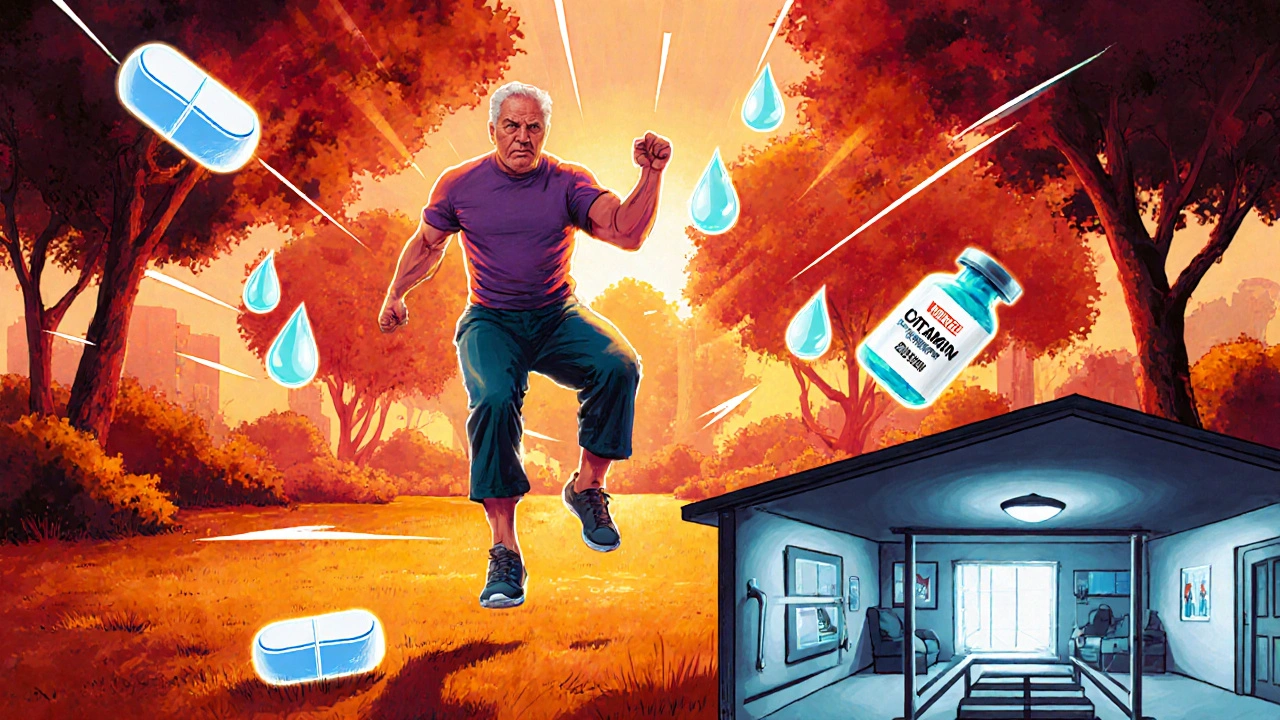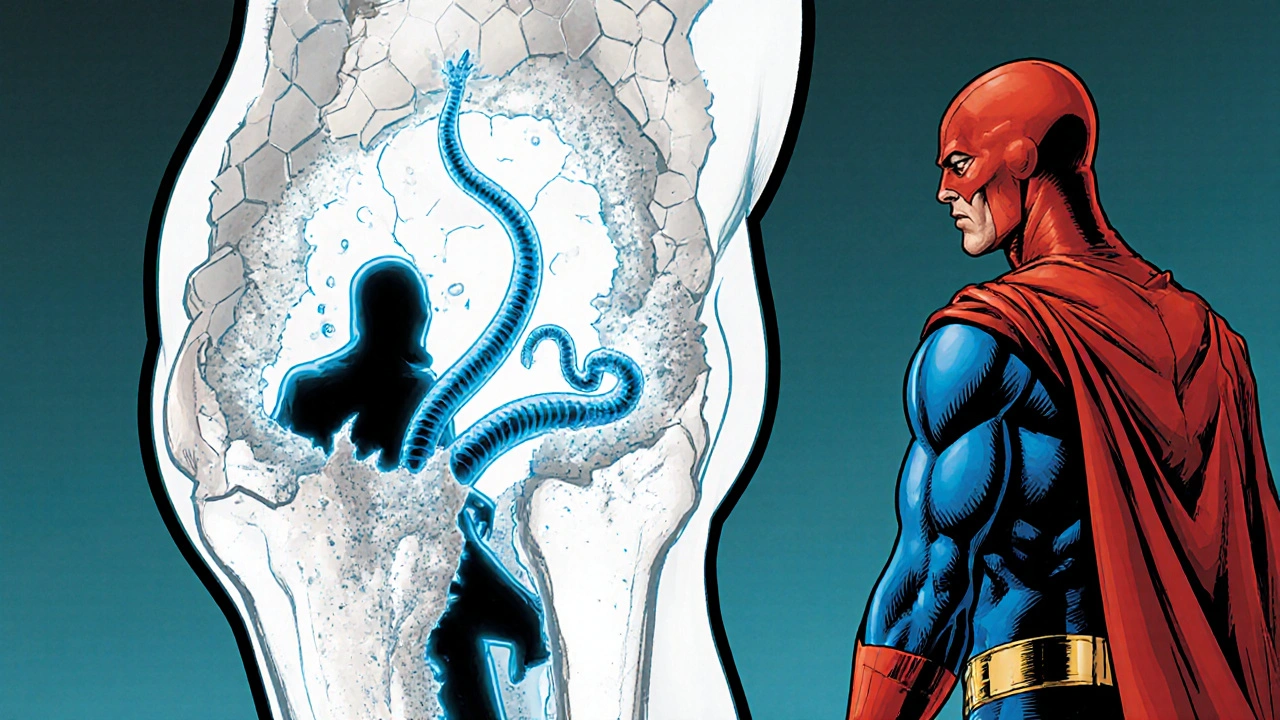Osteoporosis Risk Calculator
Bone Health Assessment
Enter your DXA scan T-score to determine your bone health status and risk level.
Bone Health Assessment
When you hear the word osteoporosis, you might picture old bones snapping like twigs. In reality, the disease creeps in quietly, stealing bone strength long before anyone feels a crack. Around 3.5 million people in the UK live with osteoporosis, yet most don’t even know it. This article breaks down what’s happening inside your skeleton, who’s most vulnerable, and how you can stop the silent erosion before it turns into painful fractures.
What Is Osteoporosis?
Osteoporosis is a systemic skeletal disorder characterized by reduced bone mass and micro‑architectural deterioration, leading to increased fragility and fracture risk. Think of bone as a honeycomb: it’s strong because of its dense walls and intricate network. In osteoporosis, the walls thin and the network collapses, making even minor bumps dangerous.
How Bone Damage Happens
Bone is a living tissue that constantly remodels - old bone gets broken down (resorption) and new bone gets built (formation). Hormones like estrogen and testosterone, plus nutrients such as calcium and vitamin D, keep this balance in check. When the balance tips toward resorption, density drops.
- Age‑related decline in hormone production (especially post‑menopause) accelerates loss.
- Long‑term use of steroids or certain anticonvulsants speeds up resorption.
- Inadequate dietary intake of calcium (a mineral essential for bone mineralization) and vitamin D (helps the gut absorb calcium) leaves the skeleton under‑nourished.
Over years, the cumulative effect can turn a healthy femur into a brittle rod, dramatically raising the chance of a fracture from a simple fall.
Who’s Most at Risk?
While anyone can develop osteoporosis, certain groups face higher odds:
- Women over 50 - estrogen drops about 80% within the first year of menopause.
- Men over 70 - testosterone falls gradually, but low levels still matter.
- People with a family history of fractures before age 65.
- Individuals with low body weight (BMI < 20) or chronic illnesses like rheumatoid arthritis.
- Long‑term users of glucocorticoids, proton‑pump inhibitors, or anti‑seizure meds.
Ethnicity also plays a part: Caucasian and Asian women tend to have lower peak bone mass, making them more susceptible.
Spotting the Silent Threat
Because bone loss produces no pain until a fracture occurs, early detection hinges on screening. The gold‑standard test is the DXA scan (dual‑energy X‑ray absorptiometry that measures bone mineral density (BMD) at the hip and spine). Results are reported as a T‑score:
- ≥‑1.0: normal
- ‑1.0 to ‑2.5: osteopenia (low bone mass, warning sign)
- ≤‑2.5: osteoporosis
Guidelines in the UK recommend a DXA scan for women over 65 and men over 70, plus anyone with risk factors regardless of age.
Preventing Bone Damage Before It Starts
Prevention is a mix of nutrition, movement, and lifestyle tweaks:
- Calcium intake: Aim for 1,200mg daily from dairy, fortified plant milks, leafy greens, or supplements if diet falls short.
- Vitamin D: 10µg (400IU) per day is the UK recommendation; most people need a supplement during winter.
- Weight‑bearing exercise: Activities like brisk walking, dancing, or resistance training stimulate bone formation. A 30‑minute session, three times a week, can preserve up to 1% of bone density per year.
- Avoid smoking and excess alcohol: Both accelerate bone loss. Limit alcohol to <14 units per week.
- Fall‑proof your home: Remove loose rugs, install grab bars, and keep lighting adequate to reduce fracture chances.
These habits don’t just stop loss; they can modestly rebuild bone, especially when started early.

Treatment Options: What Works Best?
When osteoporosis is confirmed, medication can lower fracture risk by 30‑50%. Below is a quick comparison of the most commonly prescribed agents.
| Medication | Mechanism | Typical Dose | Common Side Effects | Best For |
|---|---|---|---|---|
| Bisphosphonates (e.g., alendronate) | Inhibits osteoclast‑mediated bone resorption | 70mg weekly oral tablet | Gastro‑intestinal irritation, rare jaw osteonecrosis | Post‑menopausal women, patients preferring oral therapy |
| Denosumab (Prolia) | Monoclonal antibody that blocks RANKL, reducing osteoclast activity | 60mg sub‑cutaneous injection every 6months | Skin reactions, low calcium, rare infections | Patients with kidney impairment or who cannot tolerate oral bisphosphonates |
| Hormone Replacement Therapy (estrogen‑based) | Replaces deficient estrogen, preserving bone density | Varies by formulation (patch, tablet) | Breast tenderness, slight increase in thrombo‑embolic risk | Younger post‑menopausal women without contraindications |
All these drugs require adequate calcium and vitamin D levels. Your doctor will pick a treatment based on age, kidney function, and personal preference.
Living With Osteoporosis: Everyday Tips
Even after medication, daily habits keep the skeleton safe:
- Stay active: Mix weight‑bearing moves with balance exercises like tai chi to cut fall risk.
- Regular check‑ups: Repeat DXA scans every 2‑3years to gauge treatment effectiveness.
- Mind medications: Some over‑the‑counter drugs (e.g., high‑dose steroids) can sabotage bone health; discuss alternatives with your GP.
- Watch your weight: Both under‑weight and sudden weight gain strain bones.
Support groups and online forums can also provide encouragement, practical advice, and a sense of community.
Frequently Asked Questions
Can men get osteoporosis?
Yes. Men lose bone density more slowly, but after age 70 the risk approaches that of women. Low testosterone, chronic lung disease, and prolonged glucocorticoid use are key triggers.
Is a calcium supplement enough to prevent fractures?
Calcium helps, but it’s only part of the puzzle. Without adequate vitamin D, calcium isn’t absorbed well. Combine both nutrients with weight‑bearing exercise for the strongest defense.
What lifestyle changes can lower my fracture risk?
Quit smoking, limit alcohol, eat calcium‑rich foods, maintain a steady vitamin D supplement, and incorporate balance‑training activities like yoga or tai chi. Also, modify your home to remove tripping hazards.
How often should I get a DXA scan?
If you’ve been diagnosed and are on treatment, repeat the scan every 2‑3years. If you’re only being screened, follow your doctor’s advice-usually every 5years for low‑risk individuals.
Are there natural remedies that work?
Herbs like red clover and soy contain phytoestrogens, but scientific proof of fracture reduction is limited. Stick to proven nutrients (calcium, vitamin D) and talk to a GP before adding supplements.

Shivam yadav
September 4, 2025
Hey folks, just wanted to add that getting your vitamin D levels checked is as crucial as the DXA scan itself. In many parts of India we have limited sunlight during winter, so supplementation becomes important. Pair that with calcium‑rich foods like paneer and fortified milks, and you give your bones a solid foundation. Also, try to spend a few minutes outdoors daily – even a short walk can make a difference. Keep an eye on your diet and don’t forget that regular weight‑bearing exercises like brisk walking or dancing help maintain bone density. Stay proactive and share any tips you’ve found useful for staying bone‑healthy!
pallabi banerjee
September 11, 2025
Thank you for breaking down the science in a clear way. It’s interesting how different cultures view bone health – in some Indian families, mothers encourage dairy for strong bones, while others focus on leafy greens. Understanding where you stand with a simple T‑score can guide small, daily changes. Even a short session of yoga can provide gentle resistance for the spine. Remember, consistency over perfection is key. Stay gentle with yourself and keep learning.
Alex EL Shaar
September 18, 2025
Wow, look at all the hype around “bone health” like it’s a new fad diet. People skip real facts and just throw “drink milk” at the problem – as if calcium alone is the magic bullet. Honestly, most of us don’t even know what a T‑score is, let alone how to interpret it. The article’s code snippet is slick but half the readers will never press ‘Calculate Risk’ because they’re too busy scrolling memes. And spare me the “weight‑bearing exercise” mantra – not everyone can lift weights, especially when the gyms are full of Instagram influencers. Maybe focus on basics before you start sounding like a textbook.
Anna Frerker
September 25, 2025
The UK’s emphasis on osteoporosis feels like they’re bragging about their health system while ignoring other nations.
Brittaney Phelps
October 2, 2025
Great summary! If you’re reading this, take a quick walk today and think about how each step helps your skeleton stay strong.
Kim Nguyệt Lệ
October 9, 2025
The article is well‑structured and informative.
Rhonda Adams
October 16, 2025
Loved the supportive tone! Keep spreading the word about bone health, it really matters 😊